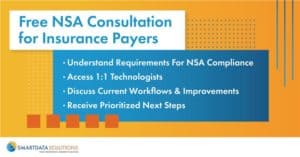2022 is upon us which means the final rule of the No Surprises Act (NSA) is in effect. As a brief summary of the NSA, it’s a rule focused on increasing transparency of medical billing for medical care performed by an Out-of-Network Provider. The Departments of Health and Human Services (HHS) introduced the rule in 2021 with a deadline of Jan. 1, 2022, for insurance Payers to comply.
The complexity with this rule lies in insurance Payers carrying the burden of updating administrative workflows with the technology needed for compliance. For example, how can Payers quickly determine whether a claim is or isn’t a surprise bill? If a claim is a surprise bill, then how do they determine the Qualified Payment Amount (QPA) at scale?
Navigating these changes is much easier with an industry expert at your side. We prepared our team at Smart Data Solutions for the No Surprises Act so we can guide our clients through these changes. The below workflow brings transparency to our process, showing how we can support you at every stage.
Tackle the NSA together by requesting a consultation today.
SDS’ Transparent Process for NSA Has No Surprises
We broke down our process into five steps that show how we support insurance Payers by creating a scalable workflow that complies with the new rule.
View Our: No Surprises Act QPA Workflow
- SDS receives a claim. We integrate with any Provider Network and receive files in any format.
- Determine whether the claim is a Surprise Bill. If a surprise bill is pre-identified in the claim, then SDS alerts and queues it for review. If a surprise bill is not pre-identified, but SDS identifies it while reviewing the claim, then SDS routes the claim through the next steps. If the claim is not a surprise bill, then it’s processed normally and sent to the Payer system.
- Modify the amount. We modify the amount and reason annotation, then send it to the Payer to accept or modify the QPA amount.
- Normalize QPA 837 mapping. We receive the updated claim and use machine learning and automation to normalize QPA 837 mapping to any standards needed.
- Online reporting. The last step is reporting on our efforts. We deliver reporting online through our QuickClaim portal and route the claims to the Payer system.
Our in-house technologists can adapt this process for different client requirements, such as final file formats, deadlines, automated triggers, and department or user access.
Conquer the No Surprises Act with Smart Data Solutions
Technology, automation, and industry knowledge are key for insurance Payers to comply with the No Surprises Act. Smart Data Solutions has 20+ years of experience with helping Payers optimize claim workflows. The NSA is the next evolution for workflows—and we can help you navigate it.
SDS Services for No Surprises Act
Smart Data Solutions helps businesses optimize their workflow no matter their current processes or end requirements. The below services are ideal for complying with the No Surprises Act, but a consultation with our technologists will determine the best way to move forward for your specific situation.
- Machine learning + automation to scan for surprise bills that aren’t pre-identified
- Determining QPAs
- Claims routing
- 837 Mapping
- EOP to 835
- Claims workflow optimization
- Strategy and implementation consulting
Request a consultation with SDS’ technologists today to determine the best starting point for optimizing your workflows.

